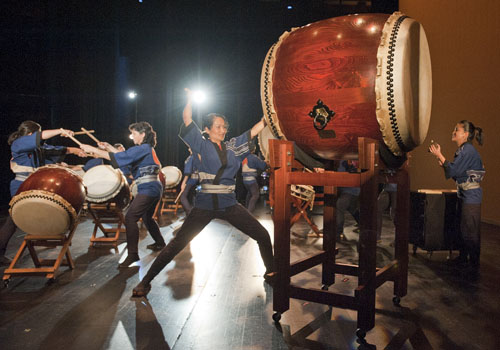
bang the drum quickly in this 2010 archive photo © Rich Iwasaki.
Exciting things happen when departments collaborate—it’s one of the best parts of attending a university with so many disciplines being taught at a high level. If you were around last year, you might remember “Drama! Dance! Drums!”
This showcase brings Japanese students’ focus on the arts together with the music department, resulting in a high-powered variety show that is sure to entertain even a total newcomer to Japanese art forms like taiko and rakugo.
The second annual night of group and solo Japanese theatre performances by PSU students and faculty will return this Thursday at Lincoln Hall. The show is presented by the Center for Japanese Studies, the Department of World Languages and Literatures and the School of Music.
Performances will include taiko (group percussion), rakugo (storytelling), shimai (noh dance), nihon buyo (classical folk dance) and kyogen (comic theater). This year, the performances will be led by Wynn Kiyama, a professor of musicology and ethnomusicology, and
Matthew Shores, a professor of Japanese studies.
“Performing arts programs offered by our Japanese studies faculty with interests in that area offer a remarkable and entertaining introduction to a side of Japan that normally requires going to Japan…to experience,” said Ken Ruoff, the director of the Center for Japanese Studies. “Students, community members, staff and faculty [would] do well to seize the opportunity to avail themselves [of] ‘Drama! Dance! Drums!’”
Shores and other organizers brought the event back after last year’s success.
“Last year, the show was a big hit,” Shores said. “The response was so positive that we decided to do it again. We tailor it to have you on the edge of your seat—this is an action-packed program.”
Shores is a PSU graduate and will be performing alongside his students.
“Japanese studies can really take you anywhere, including right back here to your teacher’s chair,” Shores said. “To be back here teaching as an alum is quite an honor. My students are all very talented and brave. They’re all risk-takers.
“We’ll have singing, dance and medieval comedy called kyogen,” Shores continued. “We’ll also do quick bits of comic storytelling with a two-man stand-up duo. We’re doing this really unique fusion of noh and butoh too.
“Noh is the medieval drama of Japan,” Shores said. “It’s often tragic, very graceful and profound. It alludes to the poetry and prose classics of Japan. So we’re going to be fusing this drama with a modern Japanese dance style called butoh—it has influence from classical ballet and the underworld; horror, if you will, gothic.
“There will be things to make you laugh and things to make you…a little uncomfortable—butoh has that effect,” Shores said. “It’s an artistic discomfort.”
Another theatrical form featured in the show is kyogen, which ought to have quite the opposite effect.
“Kyogen is medieval Japan’s comic theatre,” Shores said. “It’s inseparable from the medieval serious drama style. Kyogen traditionally served as comic relief [amid] day-long noh shows.
“Kyogen was always shorter and very light, meant to allow the audiences to take a breather from all the heavy stuff,” Shores said. “It’s much more earthy—it’s literally a parody of noh. The costumes are more bold and comical.”
The theatrical performances will be in both English and Japanese, including some that will blend the two.
“There’s going to be enough English…that non-Japanese-speakers will be able to follow it,” Shores said. “Kyogen involves very exaggerated movement—it’s very intentional, so people will be able to deduce what’s going on. But there will be opportunities for the audience to hear theater in Japanese, and everyone will be in traditional dress.
“Wynn and I have both had formal training with masters of our respective arts,” Shores said. “Our goal is to give the PSU community something authentic.”
One of the unique things about this show is that it includes performances by the professors right along with their students. Wynn Kiyama, who directs the PSU taiko group, will be performing a couple of nihon buyo dances, and his taiko course will play four pieces during the show.
“We do [a] traditional Japanese taiko repertoire. We also have the students write new compositions, so this quarter we’ll be premiering one of theirs,” Kiyama said. “It will be a nice range of pieces at the concert.
“Taiko is a robust performing art,” Kiyama added. “It has a lot of choreography with full-body motions, so I think it appeals not only to musicians and folks who are interested in East Asian performing arts, but also anyone who has a sensitivity to how the body moves—and moves efficiently—so folks who are from a sports or dance background can also appreciate the movements in taiko. There is also the very visceral pleasure of seeing and hearing large drums onstage. It’s a cathartic experience.”
Shores believes that “Drama! Dance! Drums!” is a great gateway into Japanese art and culture.
“The audience is going to be experiencing some very long traditions that go way back,” he said. “It’s an introduction to what’s out there.”

